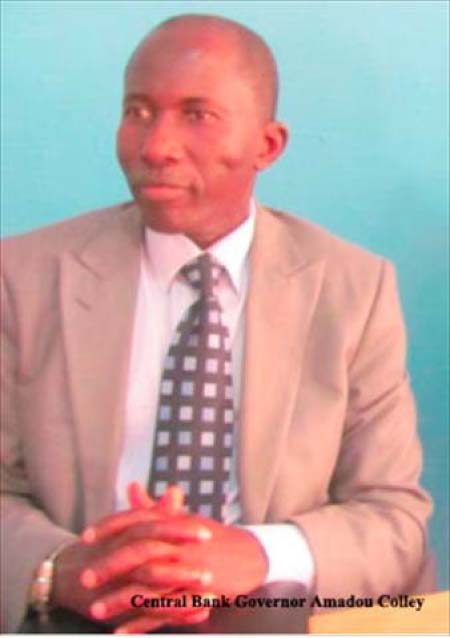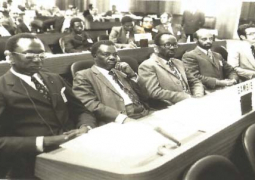
Global Economic Developments
1.Since the previous meeting of the MPC, the effects of lower oil and other commodity prices are working their way through the world economy boosting overall global growth, but weakening growth prospects in some countries.
2.According to the International Monetary Fund (IMF), growth in advanced economies is projected to expand by 2.4 percent in 2015, higher than the 1.8 percent in 2014. However, economic prospects continue to diverge. In the United States, despite slower than expected growth in the first quarter of 2015, growth is expected to strengthen and become increasingly self-sustaining. In the Euro Area, economic activity is projected to be stronger than in recent years supported by low oil prices and implementation of quantitative easing. The recovery is nonetheless expected to remain modest and uneven across the region given that labour market conditions continue to be difficult in some economies and private investment remains weak.
3.Emerging market and developing economies are projected to grow by 4.3 percent from 4.6 percent in 2014. Lower commodity prices have dampened the growth prospects of emerging market commodity exporters. Output in Sub-Saharan Africa is projected to expand by 4.5 percent, down from 5.0 percent in 2014 owing in part to the marked decline in oil prices which curbed spending plans in some oil producing countries.
The Domestic Economy
Real GDP Growth
4.The Gambia Bureau of Statistics (GBoS) revised upwards the real growth rate of the Gambian economy to 1.6 percent for 2014 from the earlier estimate of 1.4 percent contraction. Agricultural output was revised to a lower contraction of 8.4 percent from the earlier estimate of 22.7 percent.
5.The services sector, accounting for 65.0 percent of GDP, is estimated to have expanded by 6.9 percent but lower than the growth of 8.1 percent in 2013. The decreased output was primarily the result of the contraction in the growth of hotels and restaurants by 9.1 percent.
6.Growth of the industrial sector was solid, estimated at 6 percent, higher than the 4.5 percent in 2013 with mining and quarrying growing by 10.1 percent, electricity and water (7.2 percent) and construction (6 percent).
Money and Banking Sector Developments
7.In the year to end-March 2015, money supply grew by 13.7 percent compared to 10.6 percent a year earlier. The increase in the growth of broad money was mainly the result of the faster pace of expansion of the net domestic assets (NDA) of the banking sector by 27.6 percent compared to 14.6 percent a year ago. The net foreign assets (NFA) of the banking sector, on the other hand, contracted by 9.6 percent due solely to the decline in the NFA of the CBG. In contrast, the NFA of the commercial banks increased by 79.3 percent.
8.Of the components of money supply, narrow money, comprising currency outside banks and demand deposits, grew at a robust pace of 15.7 percent, slightly lower than the 16.1 percent a year ago. Both currency outside banks and demand deposits rose by 15.1 percent and 16.1 percent compared to 15.7 percent and 16.3 percent respectively a year ago.
9. Quasi money, comprising savings and time deposits, increased by 11.7 percent higher than the 5.4 percent a year ago. Both savings and time deposits grew by 13.5 percent and 8 percent, albeit a slower pace to the 16.7 percent and 12.8 percent increase a year earlier.
10.Growth in reserve money decelerated to 12.4 percent, substantially lower than the growth of 32.0 percent a year ago reflecting mainly the contraction in the NFA of the CBG. The NDA of the CBG, on the other hand, increased significantly to D5.6 billion, or 92.3 percent. CBG net claims on government in particular rose to D5.1 billion, or 81.6 percent from a year earlier.
11.The fundamentals of the banking sector remain solid. Total assets increased to D28.0 billion in the year to end-March 2015, or 13.9 percent from a year ago despite the decrease in gross loans and advances by 13.3 percent to D5.4 billion. Private sector credit, accounting for 27.6 percent of domestic credit, contracted by 9.0 percent to D5.1 billion. The ratio of non-performing loans to gross loans declined slightly to 7.0 percent in March 2015 from 7.12 percent in December 2014.
12.Capital and reserves totalled D4.04 billion, higher than the D3.04 billion in March 2014. Capital adequacy ratio averaged 31.4 percent, significantly higher than the statutory requirement of 10.0 percent. Deposit liabilities increased to D16.72 billion, or 13.3 percent from March 2014. The liquidity ratio stood at 89.8 percent, significantly higher than the statutory minimum requirement of 30.0 percent.
13.The industry recorded a net profit of D0.16 billion in the first quarter of 2015 and the return on assets and return on equity averaged 0.56 percent and 3.97 percent respectively in March 2014.
14.In the year to end-March 2015, the domestic debt rose to D19.3 billion, or 38.7 percent from a year earlier. Treasury bills and Sukuk-Al Salaam, which accounted for 78.7 percent and 3.2 percent of the domestic debt, increased by 33.1 percent and 24.4 percent respectively.
15.Data on the maturity structure of Treasury bills and Sukuk-Al-Salaam indicate that the 364–day bills accounted for 56.4 percent of the outstanding stock, 182–day bills (27.3 percent) and 91–day bills (16.3 percent) compared to 55.7 percent, 28.8 percent and 15.5 percent respectively.
16.Yields on all the Treasury bill maturities declined from a year ago. The yield on the 91-day, 182-day and 364-day bills decreased from 15.46 percent, 16.70 percent and 18.48 percent to 12.71 percent, 15.64 percent and 17.70 percent respectively in March 2015. Similarly, the weighted average inter-bank rate fellto 12.7 percent in March 2015 compared to 15.2 percent in March 2014.
Government Fiscal Operations
17.Provisional data on government fiscal operations indicate that total revenue and grants amounted to D1.8 billion in the first quarter of 2015, lower than the outturn of D2.2 billion in the corresponding quarter in 2014.
18.Domestic revenue, comprising tax and non-tax revenue, amounted to D1.82 billion, an increase of 6.8 percent over the outturn in the first quarter of 2014. Both direct and indirect taxes rose by 11.7 percent and 24.7 percent respective. Non–tax revenue, in contrast, decreased significantly to D175 million, or 48 percent from the corresponding quarter in 2014. Grants decreased significantly to only D29 million compared to D539.3 million in the first quarter of 2014.
19.Total expenditure and net lending amounted to D2.3 billion, a decrease of 8.0 percent from the corresponding quarter in 2014.The budget deficit estimated at D461.21 million was financed from both domestic and external sources.
External Sector Developments
20.Preliminary balance of payments (BOP) estimates for 2014 indicate an overall surplus of US$18.8 million, significantly lower than the surplus of US$66.9 million in 2013. This was mainly on account of the worsening of the current account deficit to US$130.5 million from US$79.3 million a year ago. Of the components of the current account, the goods account deficit widened to US$207.13 million compared to the deficit of US$169.7 million. Imports rose to US$335 million, or 10.2 percent while exportsdeclined by 3.2 percent from 2013.
21.The services account surplus declined from US$65.8million in 2013 to US$45.5 million in 2014 reflecting in large part the marked decrease in income from tourism. The income account also worsened with the deficit widening from US$22.4 million in 2013 to US$23.5 million in 2014 owing to higher external interest payments. Current transfers amounted to US$56.4 million, higher than the US$47 million in 2013. Worker remittances in particular rose to US$50.1 million in 2014 compared to US$48.7 million in 2013.
22.The capital and financial account is estimated at a lower surplus of US$146.6 million compared to US$138.2 million in 2013. The surplus in the capital account decreased to US$16.6 million from US$33.5 million in 2013. The financial account surplus, on the other hand,increased to US$130 million compared to US$104.7 million.
23.As at end-March 2015, gross international reserves totalled US$95.8 million, equivalent to 3.4 months of import cover.
24.In the year to end-March 2015, volume of transactions in the domestic foreign exchange market increased to US$1.41 billion, higher than the US$1.24 billion a year ago. Year–on–year, the Dalasi depreciated against the US dollar and Pound Sterling by 21.9 percent and 10.0 percent respectively, but appreciated slightly against the Euro by 0.17 percent.
Inflation Outlook
25.Global commodity prices have decreased by 28 percent since September 2014 mainly due to the 38 percent decline in energy prices. The Food and Agricultural Organisation (FAO) Food Price Index averaged 173.8 points in March 2015, down 18.7 percent from the March 2014 level.
26.Global inflation continues to decelerate in advanced economies and most emerging market and developing economies reflecting primarily the impact of the sharp decease in oil prices as well as lower commodity food prices.
27.Despite these benign developments, the inflationary pressures witnessed in The Gambia in 2014 persisted in the first quarter of 2015. Headline inflation, measured by the National Consumer Price Index (NCPI), rose to 6.7 percent in March 2015, higher than the 5.6 percent in March 2014 and the target of 5 percent. The main driver of headline inflation was food inflation which accelerated to 8.4 percent from 6.4 percent in March 2014. Non-food inflation, in contrast, eased slightly to 4.2 percent in March 2015 compared to 4.3 percent. Core inflation, which excludes prices of energy and volatile food items, rose to 7.1 percent in March 2015 from 5.6 percent March 2014.
Decision
In light of the above considerations, the Committee decided to increase the rediscount Rate by one percent to 23.0 percent.The Committee also directed that open market operations be intensified.




